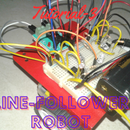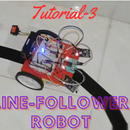Introduction: Innocence of the 'Mysterious' H-Bridge
Hello.....
For new electronic hobbyists H-Bridge is a 'mysterious' one (discrete H-Bridge). Also for me. But, in real, he is an innocent one. So, here I am tried to reveal the innocence of the 'mysterious' H-Bridge.
Background:
When I was in the 9th standard , I am interested in the field of DC to AC converters (inverter). But I don't know how it is done. I tried very much and finally I found a method, which convert DC to AC but, it is not an electronic circuit, it is a mechanical one. That is, a DC motor is coupled with an AC dynamo. When motor rotates the dynamo also rotate and produce AC. AC get from DC but, I am not satisfied because my aim is to design an electronic circuit. Then I found that it is done through H-Bridge. But at that time I didn't know very much about the transistors and its working. So I face lot of difficulties and problems so, H-Bridge is a 'mysterious' for me. But after some years I design different types of H-Bridges. That's how I discovered the innocence of the 'mysterious' H-Bridge.
Outcomes:
Now a days different H-Bridge ICs are present but, I am not interested in it. Because, it have no difficulties so no debugging is needed. When failures are occur we learn more from it. I am interested in the discrete circuit model( transistor model). So, here I am tried to remove your difficulties towards the H-Bridge. And also I believed that, this project will remove your fear towards the transistor level circuits. So, we start our journey....
Step 1: Theory of H-Bridge
How convert AC to DC? Answer is simple, by using a rectifier(mostly full bridge rectifier). But how convert DC to AC? It is difficult than above one. AC means it's magnitude and polarity changes with time. First we tried to change the polarity, because it is make the AC to be an AC. After little thinking, it is observed that polarity changed by alternating the connection of + and - simultaneously. For it we use a switch for it (SPDT). Circuit is given in the Figures. Switches S1 and S3 , switches S2 and S4 don't ON simultaneously because it produce short circuit('smoking electronics').
- When switch S1 and S4 ON positive(+) is get at point "a" and negative(-) is get at point "b" (S2 and S3 OFF)(Figure 1.1).
- When S2 and S3 is in ON positive(+) is get at point "b" and negative(-) is get at point "a" (S1 and S4 OFF)(Figure 1.2).
Bingo!! we got it, polarity changed. Here the switches are manually operated for practical application the switches are replaced by electronic components. What are the components? Simple components which control large current by applying small currents to it. Eg:- relays, transistors, mosfets, IGBT,etc... Relay is an electromechanical component, started with this. Because it is the simple one.
A working model circuit of H-Bridge using switch is given below(Figure 1.3), led indicate the polarity. Resistors are used to limit the current through the led and through which provide suitable working voltage for led.
Components:-
- Single pole Double Throw (SPDT) switch - 4
- 9V battery and connector - 1
- LED red - 1
- LED green -1
- Resistor, 1k - 2
- Wires
Step 2: H-Bridge Using Relays
What is a relay?
It is an electromechanical component. Main part is a coil, when coil energizes, magnetic field generated and it is attract a metal contact and it close the circuit. Relay contain a SPDT switch, one leg is normally open(NO), it is closes when coil energizes , other is normally closed(NC), it is closed when coil not energizes and a common node pin. Explain in the figure.
Working
Here the SPDT switch is replaced by a relay. It is the main difference from the above circuit. The relay coil consumes about 100 mA of current ,there for a driver stage is needed to increase the current by reducing the impedance. Here i am uses a transistor as the driver element. The resistor R1 and R2 are act as pull down resistors , it pull down the gate voltage to ground at no input signal condition.
The circuit diagram is given here. A toy motor is act as the load.
Components
5V relay - 2
Toy motor(3v) - 1
Transistor, T1 &T2 - BC 547 -2
Resistor R1&R2 - 56K - 2
9V battery & connector - 1
Wires
Step 3: H-Bride Using Transistors
MODEL - 1
Here the individual switches are replaced by discrete transistors. For positive charge control PNP are used and For negative charge control NPN are used. NPN is act as a closed switch when the gate voltage is 0.7V greater than the emitter voltage. Here it is also 0.7V. For PNP , it is act as a closed switch when the gate voltage is 0.7V less than the emitter voltage. Here it is 8.3V , because here PNP emitter voltage is 9V. Here the PNP transistors are ON by a NPN transistor, it act as a 180 degree phase shifter. It provide the necessary 8.3V for the PNP transistor.
Working
When input 1 is at high and input 2 is at low, T1 is ON by the switch on action of is driver transistor . Because it is NPN and the input also high. Also T4 is ON. When input is alternates the output is also alternates.The resistors R3,R4,R7,R8 act as current limiting resistor for the base current. R1, R2 act as pull up resistors for T1 and T2. R5, R6 are act as pull down resistors.
Components
T1,T2 - SS8550 - 2
T3,T4 - SS8050 - 2
Other transistor - BC 547 - 2
R1,R2,R5,R6 - 100K - 4
R3,R4,R7,R8 - 39K - 4
9V battery and connector - 1
Wires
MODEL- 2
Here the driver transistors are removed and a simple logic is used. Which reduces the hardware. Hardware reduction is very important thing. In the above model the drivers are used to to produce a negative potential( with respect to VCC) to drive the PNP . Here the negative is taken from the opposite half of the bridge. That is first the NPN is Switched on , it produce a negative at the output , it will drive the PNP transistor. All resistor used here is for current limiting purpose. Circuit is given in the figure.
Components
T1,T2 - SS8550 - 2
T3,T4 - SS8050 - 2
R1,R2,R3,R4 - 47K - 4
9V battery and connector - 1 Wires
Step 4: H-Bridge Using NE555
I am very much interested in this circuit because here use 555 IC. My favorite IC.
NE 555
555 is a very good IC for beginners. Basically it is a timer but it is also work as oscillator, switch, modulator, flip-flop, etc, and now i say that it also act as H-Bridge. Here the 555 act as a switch .So pin 2 & 6 are shorted. When a positive (Vcc) applied to its pin 2 & 6 the output goes to low and when input is low the output goes to high. The 555 output stage is a half H-Bridge circuit. So use two 555 are used.
Working
Circuit is given in the figure. When input 1 is high and input 2 low, point 'a' will be at low and point 'b' at high. when input alters output also alters. The load is a toy motor. So it is act as a motor driver because it changes the motor rotation direction. the capacitors stabilize the comparactor voltage( inside the 555 ic). Resistors act as pull ups for when no input applied.
Components
NE555 - 2
R1,R2 - -56K - 2
C1,C2 - 10nF - 2
Toy motor - 1
9V battery and connector - 1
Wires
Step 5: H-BRIDGE IC
I believed that all heard about the H-Bridge IC or DC motor control IC. Because it is common in all motor driver modules. It is simple in construction because no external components needed only wiring. No difficulties for it.
The commonly available IC is L293D. Others are also available.

Participated in the
Electronics Tips & Tricks Challenge











